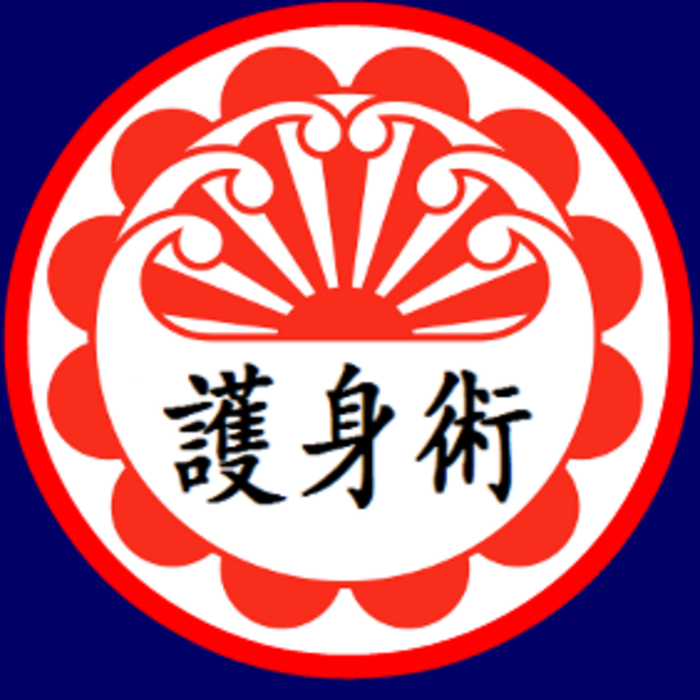Competition Rules
General regulations for the conduction of a competition in GOSHIN JYUTSU (Art of self-defense) Tokio 2013-2018
The following regulations shall be used as a guideline for the organization of competitions.
The following regulations provide a guideline for the most significant issues, such as the organization of competitions, judging and the duties of the refereeing panel. The regulations are elaborated by the methodical council of the World Martial Arts Federation (Sekai Bujyutsu Renmei).
TATAMI - mat for technical excercises
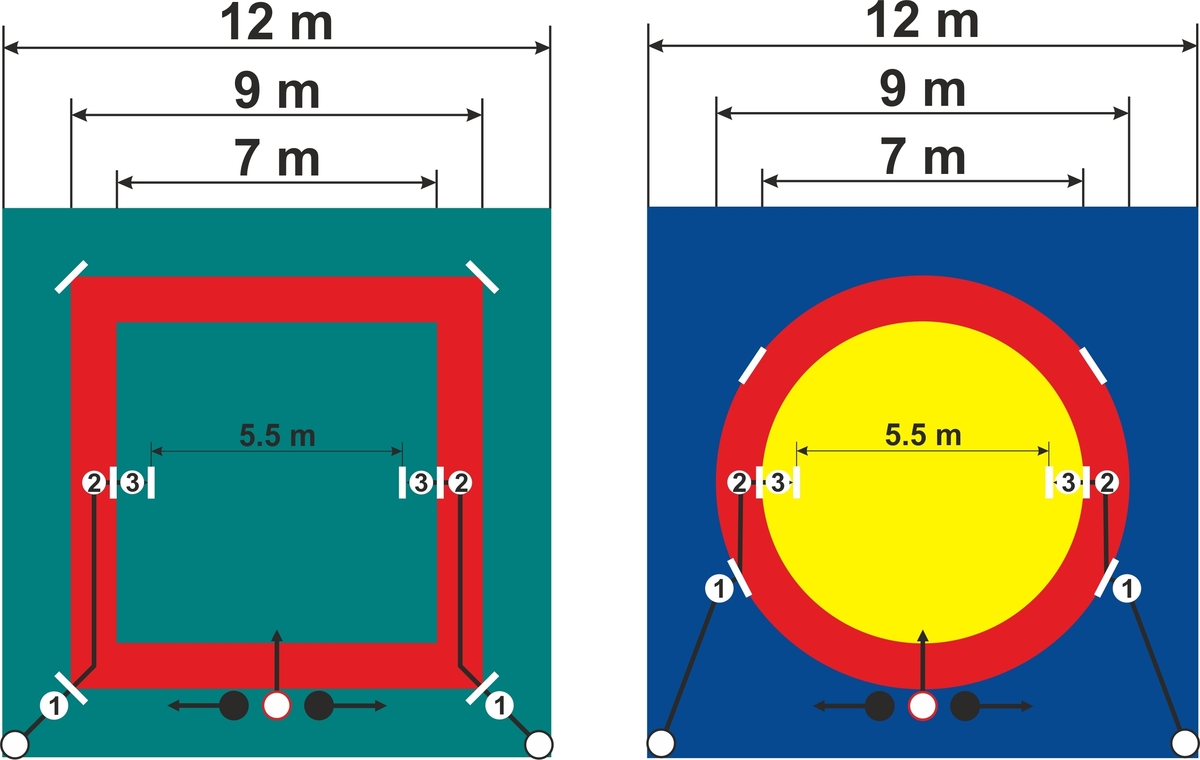
1. TATAMI REI — bow to the mat
2. ATAGAI NI REI — bow to each other
3. SONKYO — take the squat position
Evaluation criteria for referees in КАТА

Evaluation criteria for referees in a competition.
ATTACK-EVALUATION
1. Demonstration of blows at the focus mitts
2. Demonstration of a grip with a following technique without counteractions.
3. Demonstration of an attack with a training weapon
4. Estimation till 5 scores:
a. Power
b. Speed
c. Technical efficiency
5. Lowering of the score-the attacker performing the examination task shall attack ONLY the body parts of the respondent which are protected by protective equipment with maximal power, speed and technical efficiency: a. In case of a visible decreasing of the efficiency of the attack during a demonstration and/or performing an examination task 1 score will be subtracted from the attacker and a second try will be assigned. b. In case of an unsuccessful second try 1 score will be subtracted from the attacker again. DEFENSE - EVALUATION 1. Performance of a technique of own choice. 2. A self defense technique ends up with an imitation of a finishing blow or a joint lock. 3. Estimation till 5 scores а. Speed b. Technical efficency CONDITIONS
1. Examination task - the same for both effectives.
2. After the drawing the both effectives are assigned to the role of either the attacker or the respondent. After performing of the examination task the roles are exchanged.
3. With a minimum score of 3 mutually assigned by all judges the attacker will be suspended from the competition. A replacement has to be carried out.
4. After a demonstration of the attack by both effectives which were rated by the judges with a score higher than 3, the examination task can be performed.
5. The scores assigned for the performance of attack and defense techniques will be added up.
6. The Chief Referee and the Secretary take place at the table
7. Two FUKUSHIN - side judges, seated on chairs equipped with notepads and scoring lists ranging from 0 to 5, and one CHUSHIN - Main Referee are located beyond the line of the mat.
8. Defined movements of the attendees in two steps:
a. Movements before performing a technique. b. Movements after performing a technique. CATHEGORIES OF ATTACKS - А, В, С, D, Е А. Single arm and leg blows. B. Double arm and leg blows, grips. С. Single blows with training cold arms (Tanto - rubber knife, yawara flexible sword, jyuken - stick of 120cm with soft protective caps) D. Double blows with training cold arms and a threat with training fire arms at a close operating distance. E. All kinds of attacks within above-named categories, defense with frontal binded or handcuffed hands. Note: 1. Categories A and B have no attendance restriction. 2. Categories C, D, E are restricted to adult effectives ONLY.
PROHIBITED ACTIONS
1. Full-contact hits on body parts of the opponent which are not protected by protective equipment are prohibited.
2. Full-contact hits at the helmet and head of the opponent laying on the ground are prohibited.
3. It is prohibited to lift the opponent up to perform a throw that could cause injury.
4. Hitting attacks on the joints are prohibited.
5. Axillary grips that could cause fracture are prohibited.
6. It is prohibited to grab the opponent's helmet at the ear protection, to lift the opponent grabbing a protective waistcoat and to grab the opponent's helmet with both hands.
7. Attacks after the match has ended are prohibited.
8. Any kind of speech during the match, as well as speech and actions abusive to the opponent or the referee panel are prohibited.
9. It is prohibited to delay a match.
10. The execution of dangerous and harmful actions that could cause an injury of the opponent as well as any other dangerous actions are prohibited.
Gestures of the Main Referee (chushin)
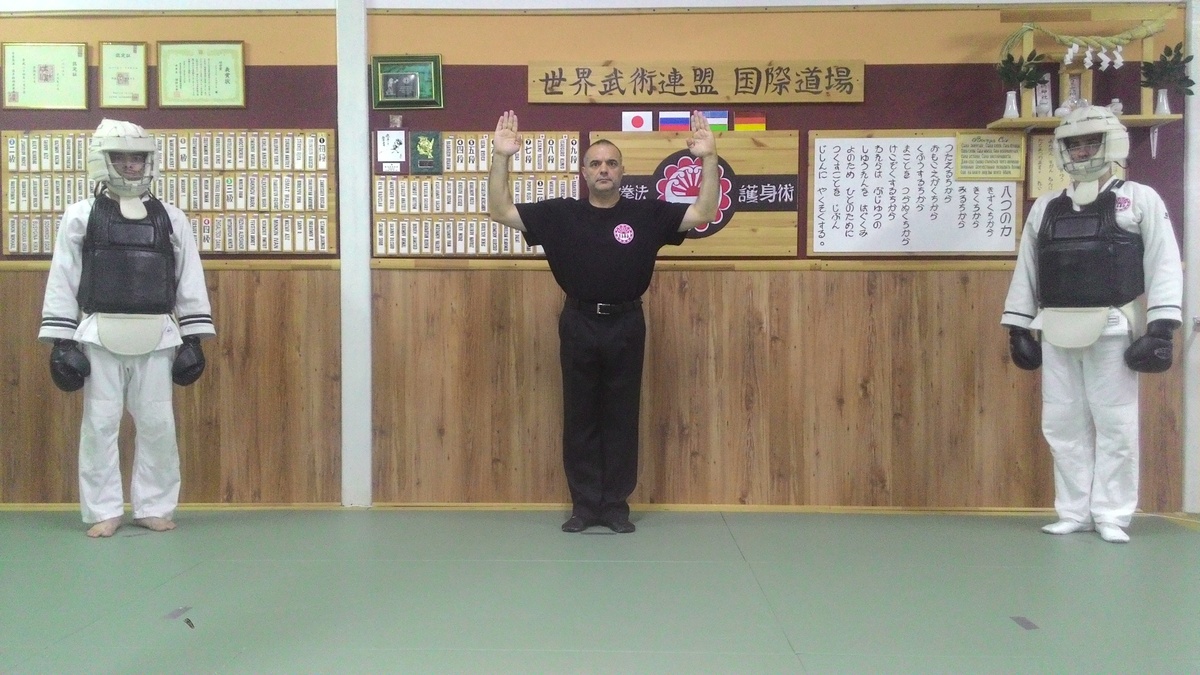
 TATAMI REI - bow to the mat
TATAMI REI - bow to the mat
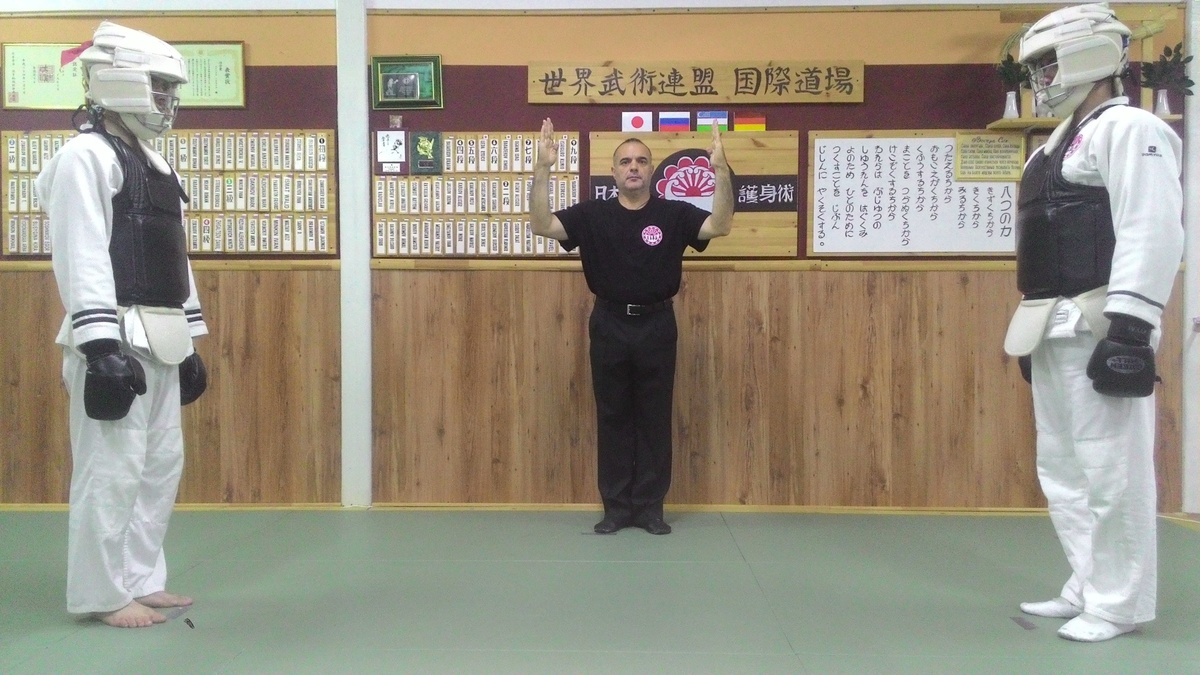
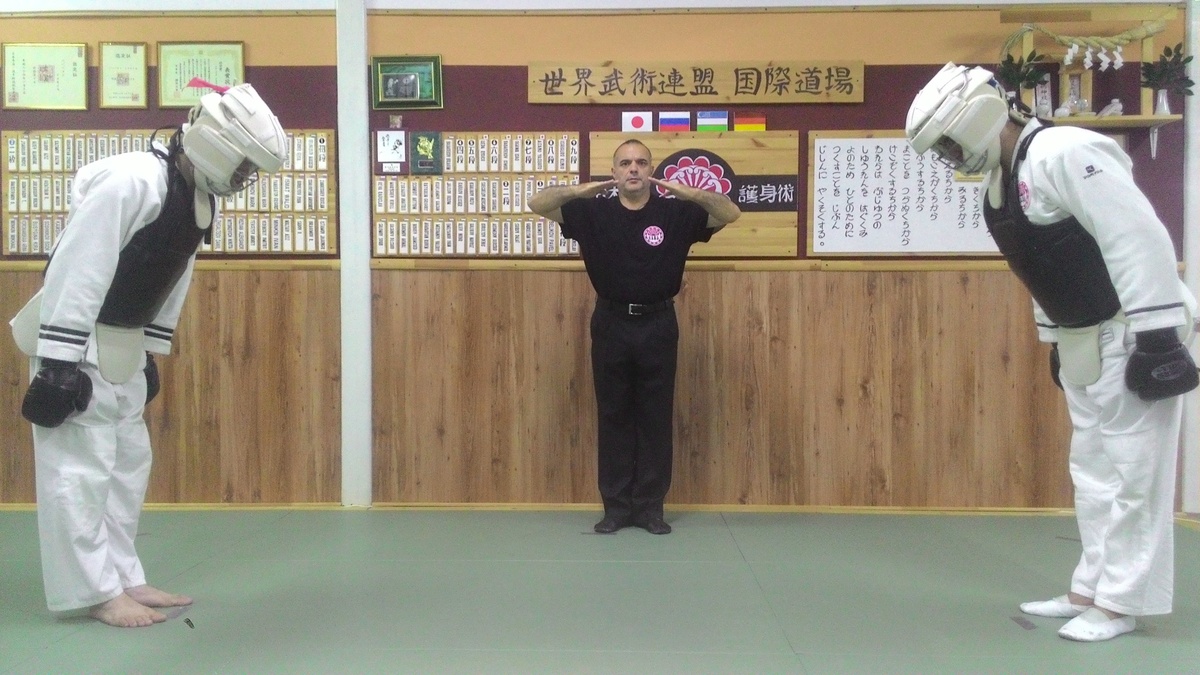 ATAGAI NI REI - bow to each other
ATAGAI NI REI - bow to each other
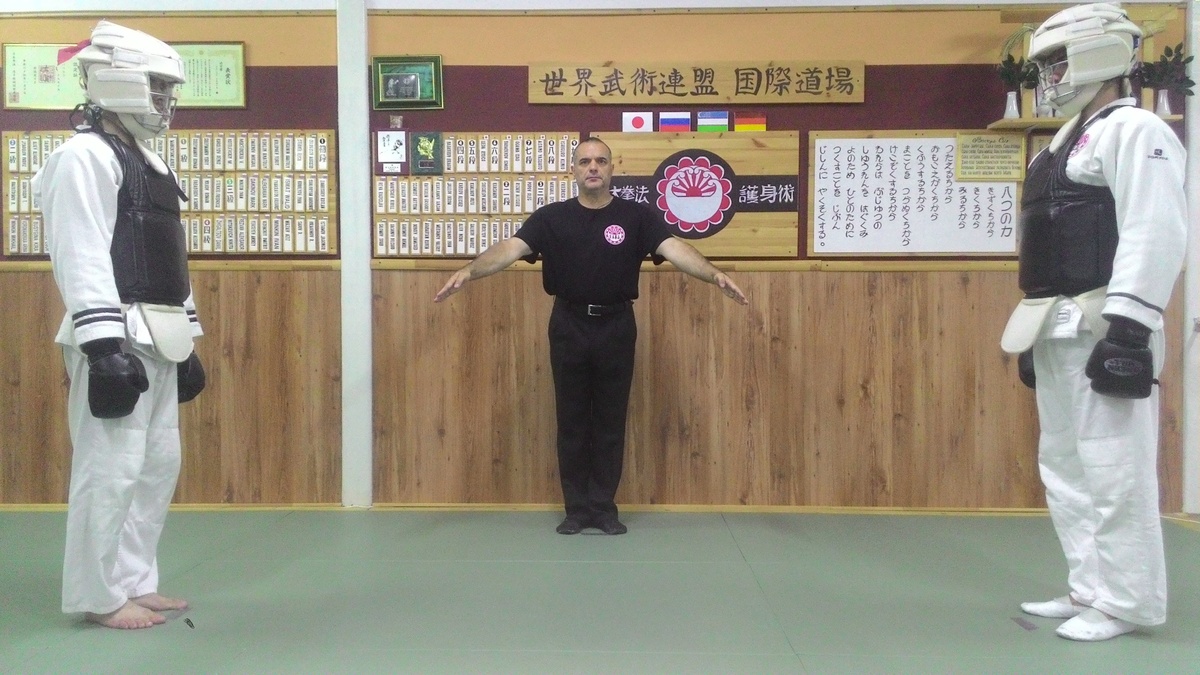 MOTO NO ICHI - starting position
MOTO NO ICHI - starting position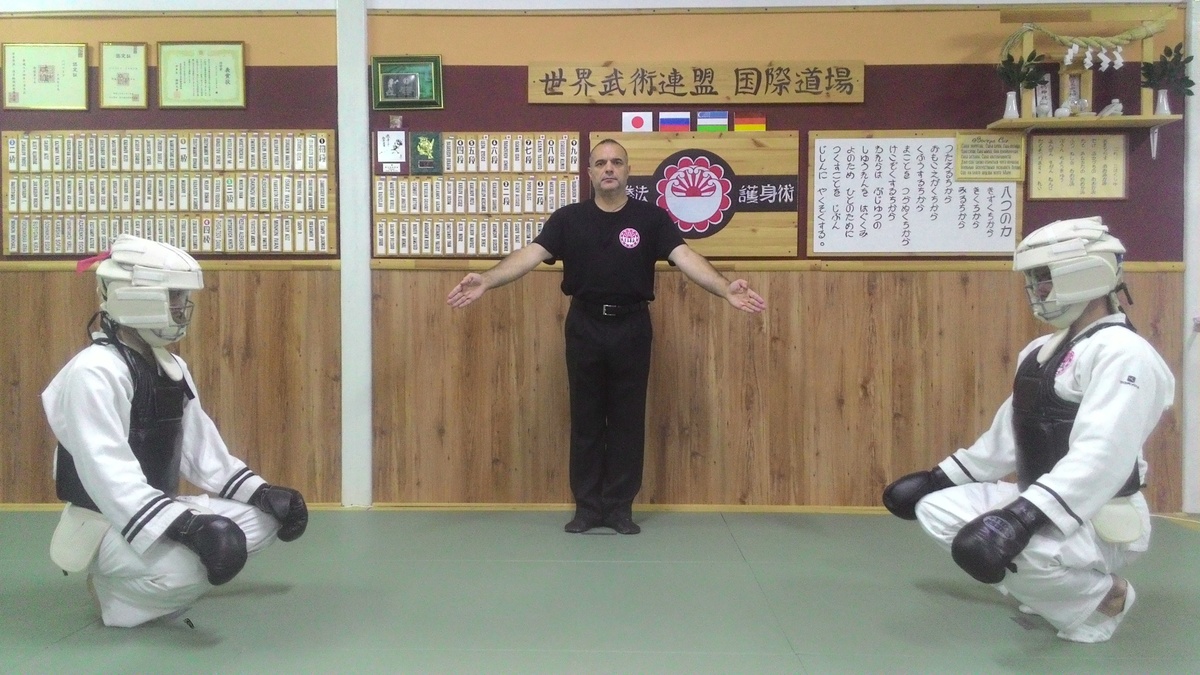
 SONKYO - squat position
SONKYO - squat position
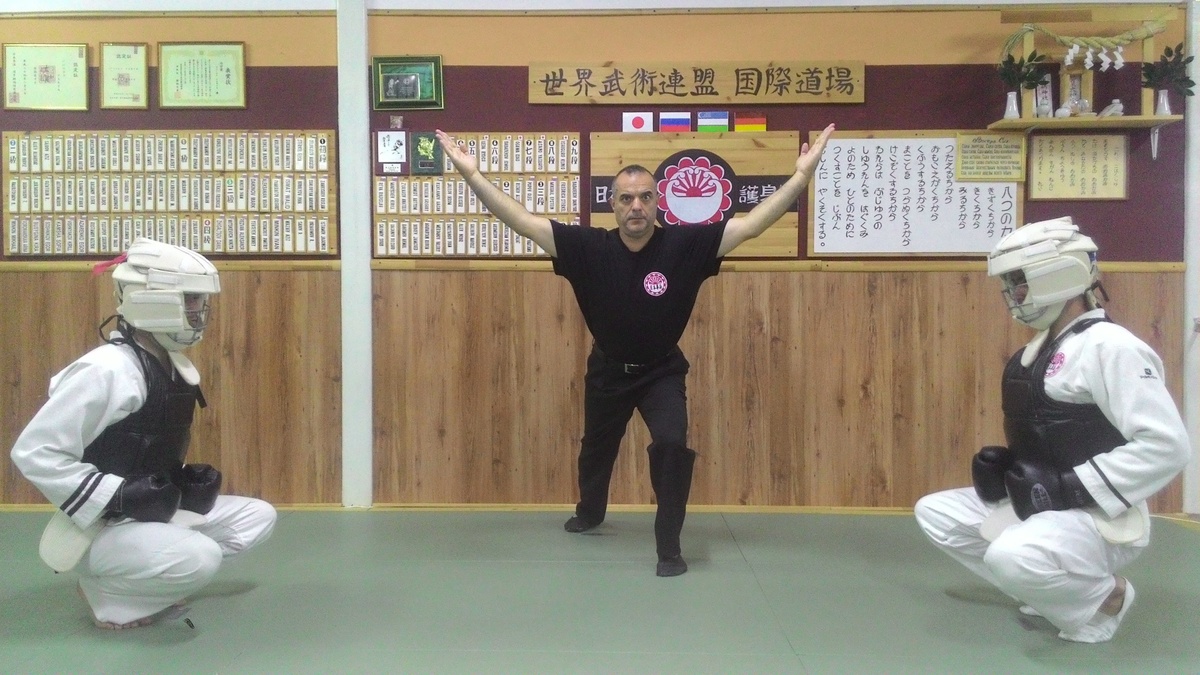

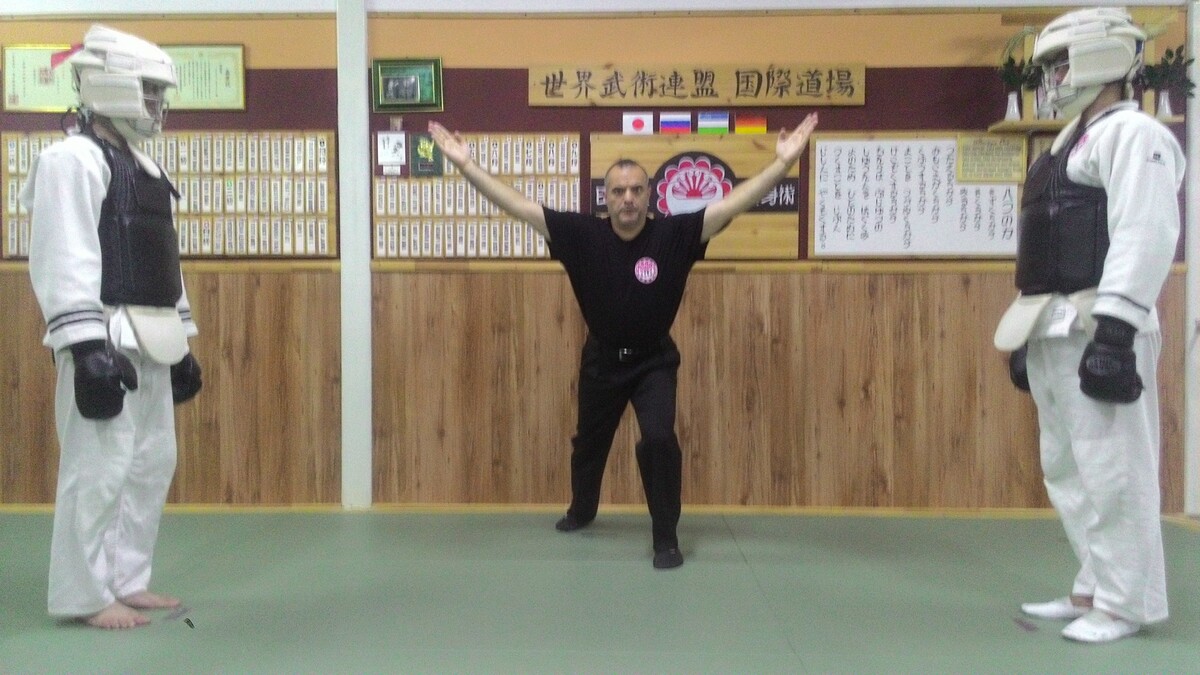
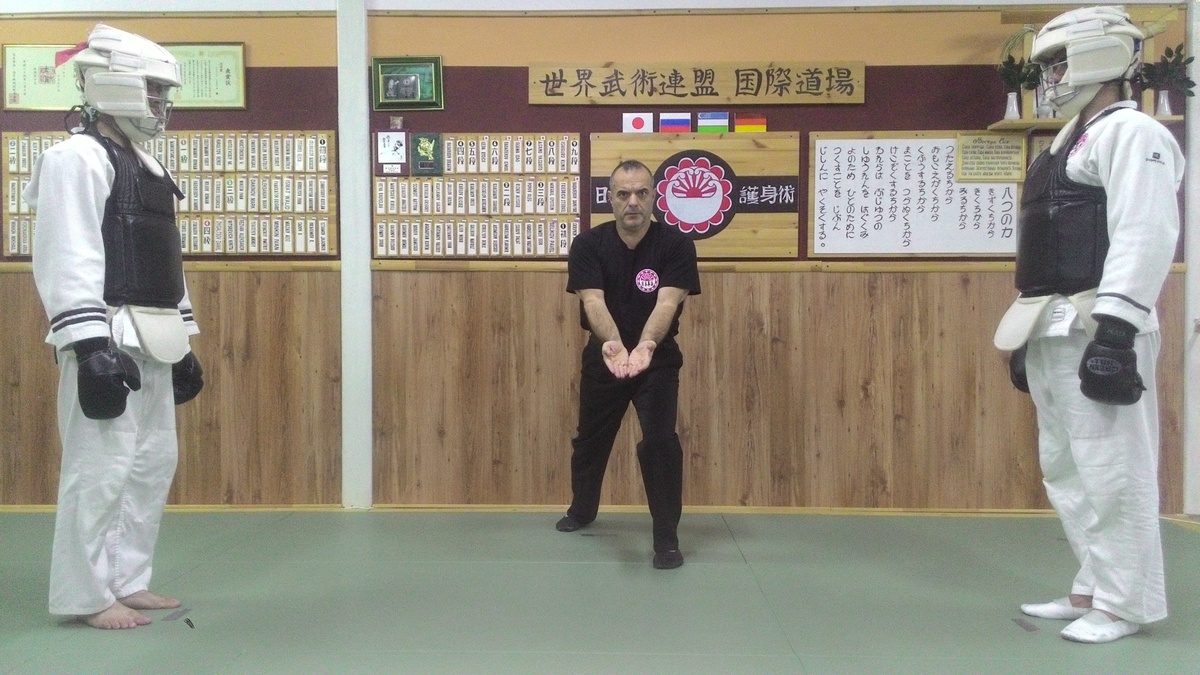 HAJIME - begin
HAJIME - begin


 TORIMASEN - no score awarded
TORIMASEN - no score awarded

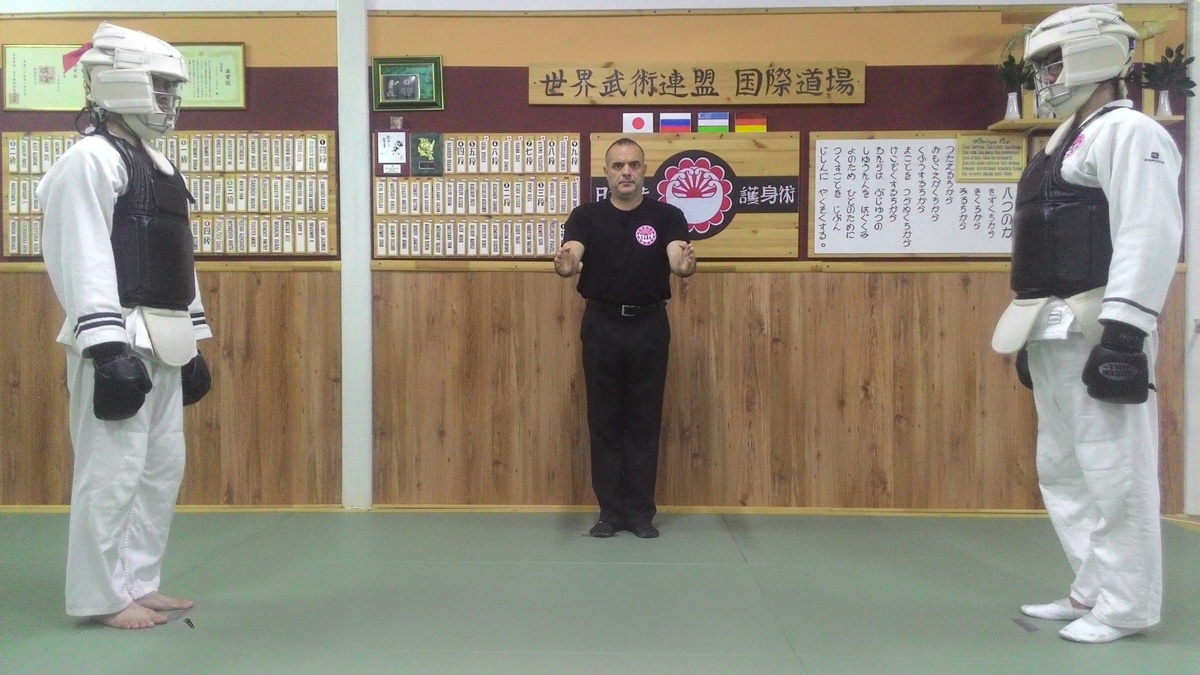 HIKIWAKE - tie
HIKIWAKE - tie
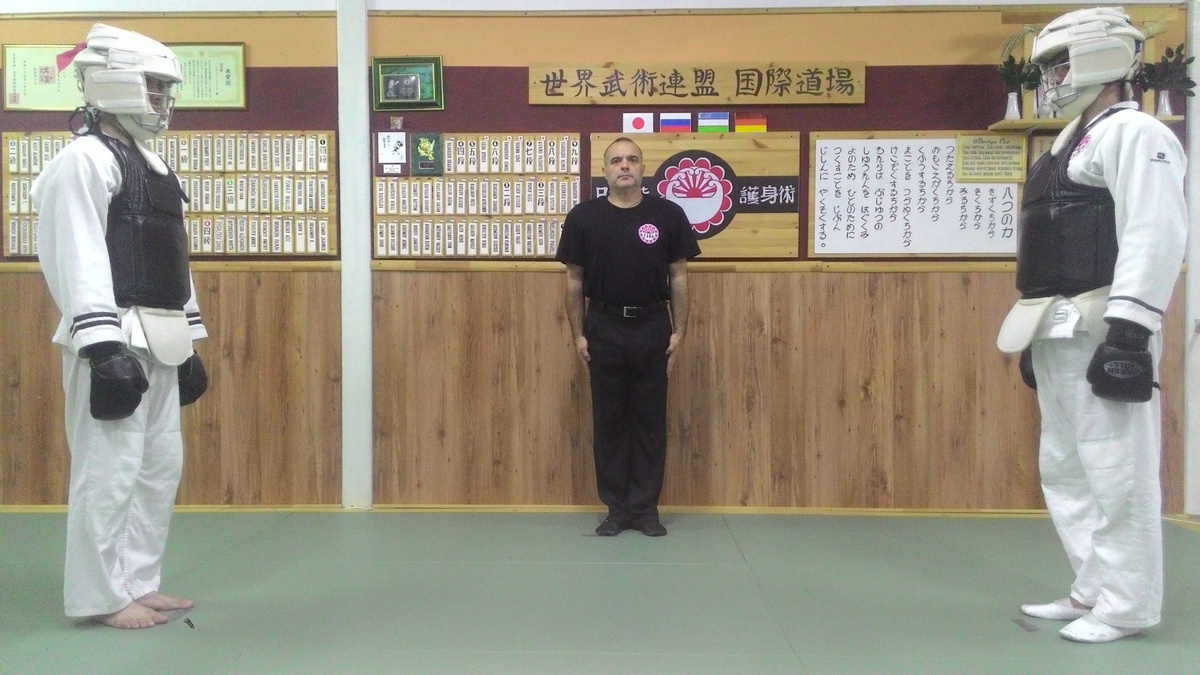 HANTEI - without gesture collective decision
HANTEI - without gesture collective decision
 HANTEI - gesture to the side judjes; short meeting for decision making
HANTEI - gesture to the side judjes; short meeting for decision making
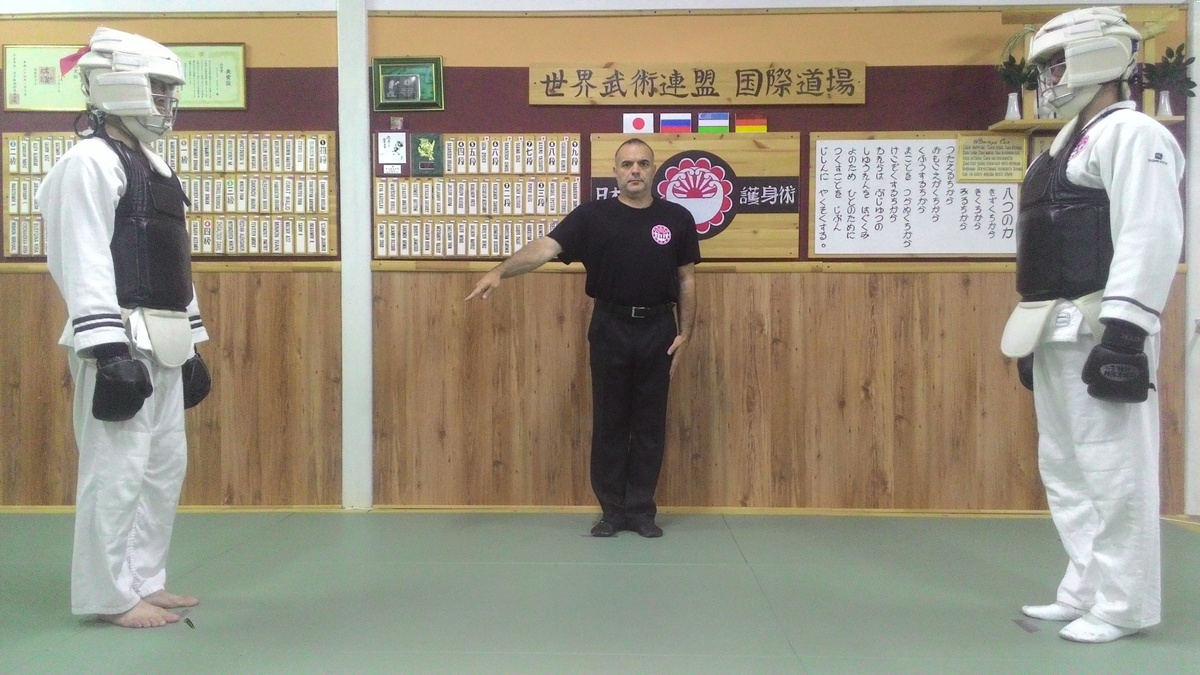 aka CHUI - warning to the RED
aka CHUI - warning to the RED
 aka KEIKOKU - strict warning to the RED
aka KEIKOKU - strict warning to the RED
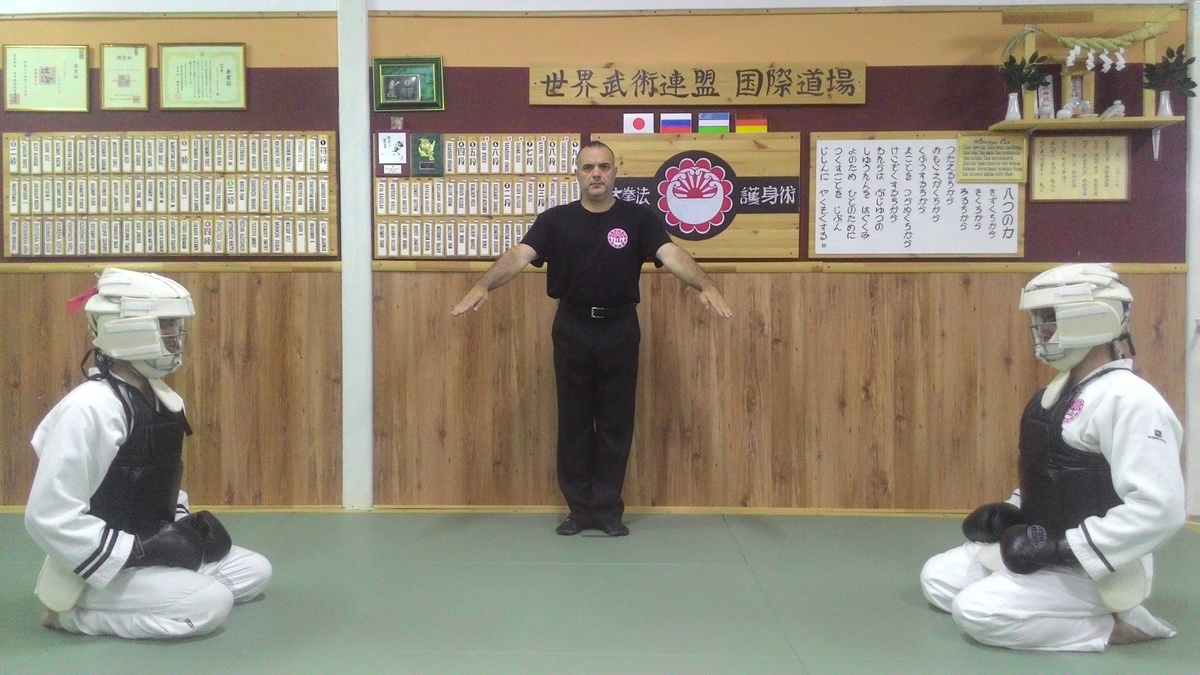 CHYAKUZA - knelling squat
CHYAKUZA - knelling squat
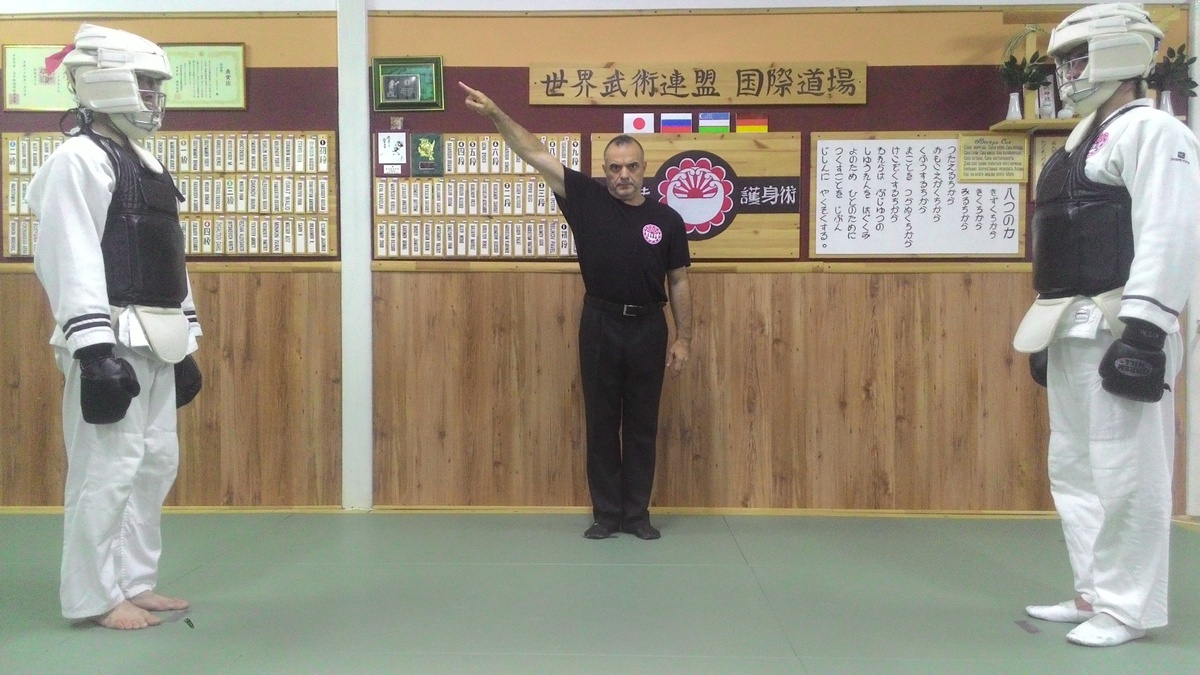 aka SHIKKAKU - disqualification of the RED
aka SHIKKAKU - disqualification of the RED
 ao KATSU - victory to the BLUE
ao KATSU - victory to the BLUE
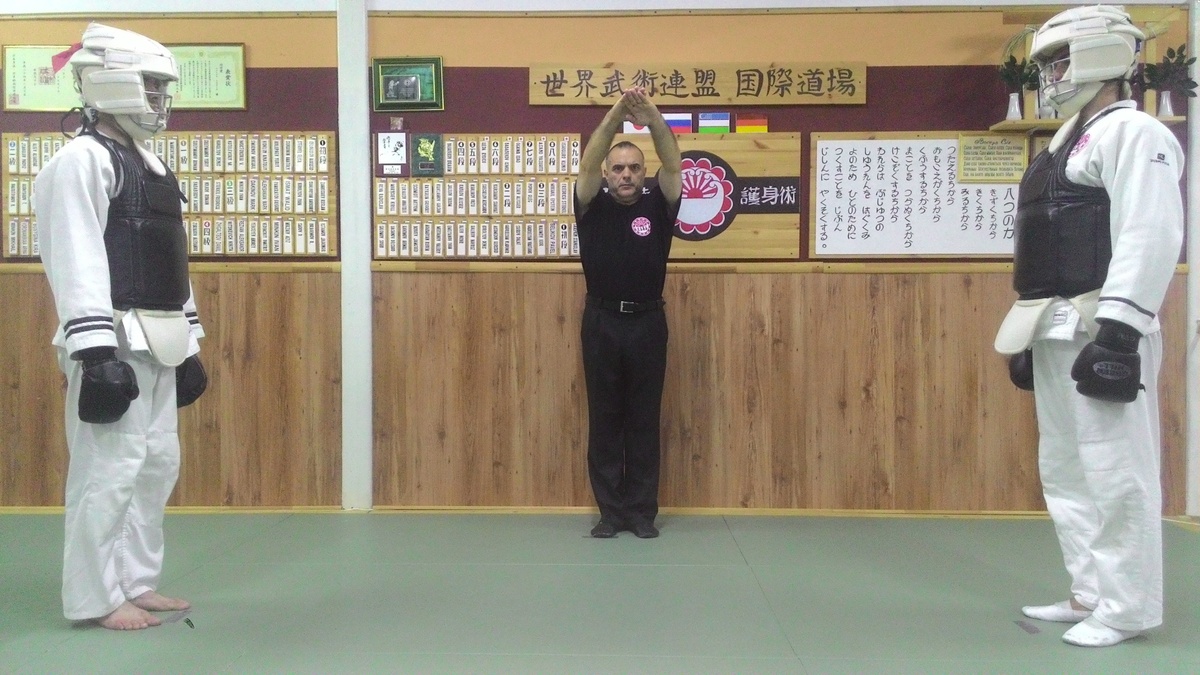
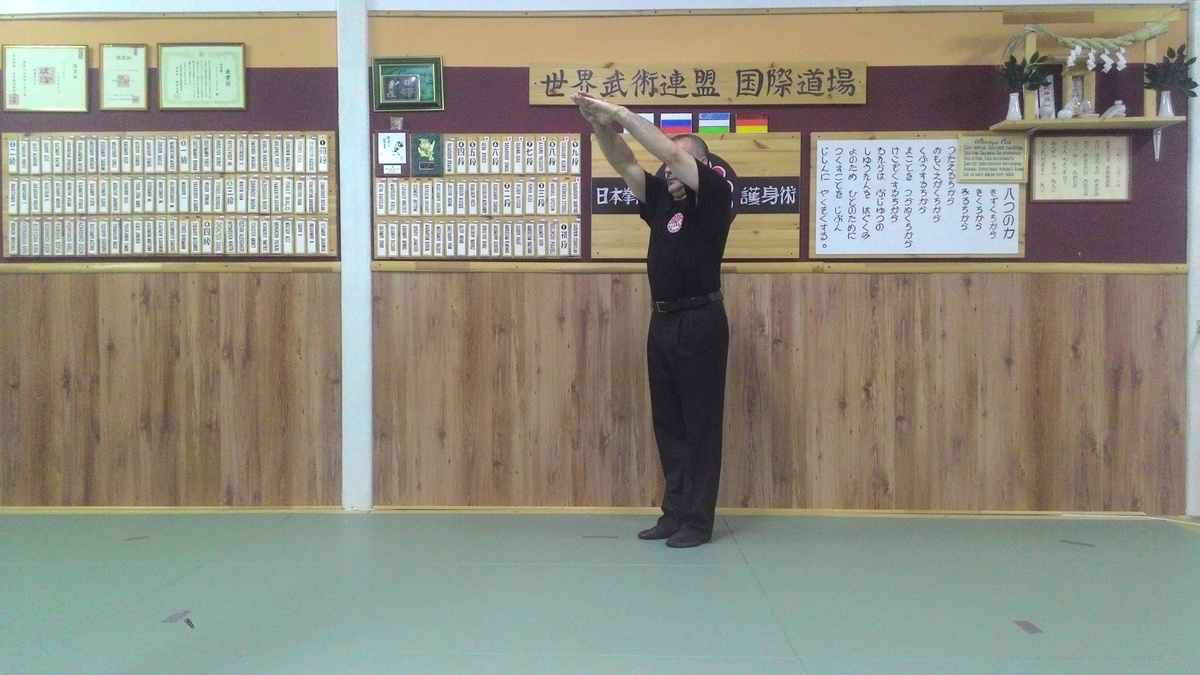 YAME - end
YAME - end
Organization of competitions
1. There are the following types of competitions possible:
a. Individual match (open weight);
b. Team match 5х5 (open weight);
c. Individual/Team match according to weight classes
2. In individual matches, only individual achievements will be measured.
3. In team matches (5x5), the achievements of the team will be measured according to the sum of scores awarded to each team member during a certain match. At the beginning of a new match, the score proportion is 0:0.
4. In individual/team matches, individual as well as team achievements will be measured. The ranking of the team is determined according to the sum of scores achieved as well as prize-winning places of each team member:
- first place - 5 scores,
- second place - 3 scores,
- third place- 1 score
5. The type of the competition should be subject of the General Regulations.
Modes of competition
1. There are three modes of competition:
a. Circular
b. Olympic
c. Hybrid
2. In the circular mode, each contestant (team) competes with any other contestant (team).
3. In the olympic mode, the contestant (team) withdraws from the competition after the first defeat.
4. In the hybrid mode, the competition will at first be conducted in the circular and further on in the olympic mode.
5. The mode of the competition shall be subject of the General Regulations.
Organization of competitions
1. The competition shall be conducted according to the relevant rules and regulations.
2. The organization responsible for the conduction of the competition has the following duties:
a. Elaboration and confirmation of the regulations for the competition
b. Creation of an organizing committee for the preparation and conduction of the competition
c. Nomination and confirmation of the appropriate referee panel
d. Providing of material, technical and medical solutions required for the competition
e. Providing an accommodation and catering for competitors, representatives and referees, as well as ensuring transportation and stuff services
f. Ensuring an appropriate location for the conduction of the competition
General Regulations of the competition
1. The General Regulations are considered as a master document of reference for the referee panel as well as for the competitors.
2. The General Regulations shall not be contradictory to the Rules.
3. The General Regulations should provided on the following occasions: at least one month before the beginning of district or town competitions, and at least four month before the beginning of regional or international competitions.
4 The General Regulations include the following articles:
a. Objectives and tasks
b. Time and location of the competition
c. Conduction of the competition
d. Participating organizations and attendees, their qualification and age, team personnel
e. Agenda, type and mode of the competition
f. Awarding
g. Terms of accreditation for nonresident attendees and referees
h. Procedures and terms for the application, weighing and drawing
i. Clothing and protective equipment of the attendees
5. The articles of the Regulations shall be accurate and not permitting differences of interpretation.
Applications for the competition
1. An application by name for the competition shall be delivered to an organization conducting the competition and be approved by the committee or the secretary.
2. The application shall be signed by the steering committee of the organization applying for the competition and ensealed. The application shall contain the position, rank and the names of the representative, referee and the team leader.
3. The application shall contain a medical approval, signed and sealed, for each attendee. The line for the entire number of attendees applying for the competition shall as well contain a signed and sealed medical approval.
4 A declaration for changing the application shall be delivered to the head secretary at least 1 hour before the beginning of the drawing.
Weighing of the attendees
1. The term for the weighing of the attendees is subject of General Regulations.
2. The use of several scales for the weighing is permitted, thus attendees of the same weight class have to be weighed on the same scale.
Drawing
1. The performance sequence of the attendees (teams) at the competition is determined by drawing. The drawing is conducted by the head secretary of the competition.
2. The drawing shall be conducted for each weight and age class of the attendees passed the procedure of weighing.
3. During the drawing, the most powerful attendees could be newly assigned to openents by approval of the team representatives.
4. The terms for drawing of the attendees are subject of General Regulations.
Claims
1. Claims concerning mistakes of the referee panel shall be referenced by citation of an appropriate paragraph and items of the rules as well as a video proof, and delivered to the head secretary of the competition in written form.
2. A submission of causeless claims could lead to disqualification.
3 The decision of the Main Referee on the claim is definitive and not subject to revision.
Permission to compete
1. A permission to compete in the age classes Kids, Youngsters, Juniors and Adults will be granted to attendees with appropriate skills, valid medical approval and who are included in the application.
2. The attendees shall have the following documents: budo passport; service and military personnel shall have a personal ID.
3. Scheme of permission to compete by age and qualification in disciplines
Male | Kids 10-11 years | Youngsters minor age 12-13 years | Youngsters minor age 14-15 years
| Youngsters minor age 16-17 years | Juniors 18-20 years | Adults 21+ years |
|
Half Lightweight | up to 27 kg | up to 30 kg | up to 40 kg | up to 50 kg | up to 60 kg | up to 65 kg |
|
Lightweight | up to 30 kg | up to 34 kg | up to 45 kg | up to 55 kg | up to 65 kg | up to 70 kg |
|
Half Middleweight | up to 33 kg | up to 38 kg | up to 50 kg | up to 60 kg | up to 70 kg | up to 75 kg |
|
Middleweight | up to 36 kg | up to 42 kg | up to 55 kg | up to 65 kg | up to 75 kg | up to 80 kg |
|
Half Heavyweight | up to 39 kg | up to 46 kg | up to 60 kg | up to 70 kg | up to 80 kg | up to 85 kg |
|
Heavyweight | 42+ kg | 46+ kg | 60+ kg | 70+ kg | 80+ kg | 80+ kg |
|
Female |
| Girls minor age | Girls middle age | Girls major age | Juniors and Adults | Adults |
|
Half Lightweight |
| up to 40 kg | up to 45 kg | up to 50 kg | up to 55 kg | up to 55 kg |
|
Lightweight |
| up to 45 kg | up to 50 kg | up to 55 kg | up to 60 kg | up to 60 kg |
|
Half Middleweight |
| up to 50 kg | up to 55 kg | up to 60 kg | up to 65 kg | up to 67 kg |
|
Middleweight |
| up to 55 kg | up to 60 kg | up to 65 kg | up to 70 kg | up to 70 kg |
|
Half Heavyweight |
| up to 60 kg | up to 65 kg | up to 70 kg | up to 75 kg | up to 75 kg |
|
Heavyweight |
| up to 60 kg | up to 65 kg | up to 70 kg | up to 75 kg | up to 75 kg |
|
Matches Schema of permission for international competitions | ******** | ******** | ******** | ******** | ******** | ****** |
|
| 3 Kyu | 2 Kyu | 1 Kyu | 1 Dan | 2 Dan | 3 Dan |
|
Individual |
|
|
| + | + | + |
|
Teams (5x5) |
|
|
| + | + | + |
|
Individual/ Team | + | + | + | + | + | + |
|
Kata Schema of permission for international competitions |
|
|
|
|
|
|
|
| 3 Kyu | 2 Kyu | 1 Kyu | 1 Dan | 2 Dan | 3 Dan |
|
Individual |
|
|
| + | + | + |
|
Teams (5x5) |
|
|
| + | + | + |
|
Individual/Team | + | + | + | + | + | + |
|
Self-defence Schema of permission for international competitions |
|
|
|
|
|
|
|
| 3 Kyu | 2 Kyu | 1 Kyu | 1 Dan | 2 Dan | 3 Dan |
|
Individual |
|
|
| + | + | + |
|
Individual/ Team | + | + | + | + | + | + |
|
12.4. Conditions of permission to compete are subject to General Regulations.
Rights and obligations of team representatives
1. A team attending the competition shall have a representative. As a supervisor of the team, this person is responsible for orderliness, behavior and discipline of the team members. In absence of the representative his duties shall be taken over by the team leader.
2. Obligations of the team representative: a. To be aware of the Rules and General Regulations of the competition; b. To deliver the application as well as other documents required for the attendance in competition in a timely manner; c. To be present at the joint sessions of the referee panel; d. To inform the team members about decisions of the referee panel; e. To ensure an accurately timed appearance of the attendees; f. To be wholly present at the location of the competition and leave the location solely with the permission of the Main Referee.
3. Rights of the team representative: a. To be present at weighing and drawing; b. To receive information concerning the conduction and results of the competition; c. To submit claims according to the General Regulations, including changes in the application.
4. A team representative has no right to interfere with the work of the referee panel or the organizational committee.
5. A team representative cannot function as a referee of the given competition.
Rights and obligation of the attendees
1. Obligations of an attendee:
a. To pass a credentials committee;
b. To be aware of the Rules and General Regulations and be strictly committed to them;
c. To appear at the competition in a timely manner;
d. To remain at the assigned places and keep peace and silence during the competition;
e. To follow the instructions of the referee panel, as well as exclusively the instructions of the Main Referee at the competition ground;
f. To behave politely towards all attendees, referees and the stuff of the competition; g. To ensure a neat clothing and approved protective equipment;
h. To appear at the competition ground immediately at the call of the referee panel; i. To fulfill the traditional respectful behavior at as well as near the competition ground;
j. To immediately inform the referee panel via the team representative about any reasons for quitting the competition.
2. Rights of an attendee:
a. To address the referee panel via the team representative. To address the referee panel personally during individual competition, if a team representative is absent;
b. To check his weight on the official scale one hour before the weighing procedure; c. Receive medical assistance during a 3-minute match.
Clothing and protective equipment.
1. Goshin Jutsu - for unarmed matches and self-defense:
a. KEMPOGI-V - Gi-suit with a protective layer (for military and servicemen, wearing of a uniform could be permitted upon an agreement with the organization committee)
b. MEN- protective helmet (strengthened)
c. DO - waistcoat (strengthened)
d. sparring shoes
e. boxing-gloves (strengthened)
f. jockstrap (strengthened)
g. basic and club emblem
2. The approved clothing and protective equipment shall be uniform for all attendees and subject of the General Regulations.
3. Before the appearance on the competition ground according to drawing, each attendee shall be equipped with a red or white belt. Tied up, the tail of the belt shall be no longer than 20 cm.
Note: Use of protective equipment such as MEN (protective helmet, strengthened) DO (protective waistcoat, strengthened) is exclusively permitted for a light-weight construction model released in 2018.
Instructions of the referee panel for unarmed matches
1. An approval of the referee panel shall be conducted at least 25 days before the beginning of the competition.
2. Composition of the referee panel: Main Referee, Deputy Main Referee, Head Secretary and Secretaries, Announcer, Time Keeper Judge, Referee and Side Judges, Managing Director, Physician and Video Operator.
3. A match is judged by a referee and two side judges.
4. If the competition lasts for more than 2 hours, there shall be a double stuff of referees and side judges for each competition ground.
5. The referee panel shall be equipped with appropriate clothing and have the right permission for execution of their duties corresponding to the order of the competition.
6. Obligations of the Main Referee:
а. to ensure the proper condition of the competition ground, equipment and implements as well as their accordance to the Regulations and to issue an acceptance report;
b. to appoint referee panels for the weighing;
c. if the competition requires multiple grounds, to appoint a referee panel for each competition ground;
d. to announce changes of the referee panels;
e. to call the competitors on the competition ground and to inform competitors who are due to attend the next match;
f. to take measures to prevent and rule out mistakes of the referee panel;
g. to arbitrate claims submitted by team representatives;
h. to conduct meetings of the referee committee and team representatives at the beginning of the competition, daily at the end of the competition to confirm the achieved results, as well as when required in whatever cases concerning the competition;
i. to rate the work of each referee on a 100-degree scale and conduct a report for Sekai Buyutsu Renmei concerning increasing or decreasing the rank of each referee in virtue of the recording, notes of the judges and video records;
j. to timely deliver the record of the competition as well as own advisory opinion to the organization conducting the competition.
7. Rights of the Main Referee:
а. to delay the competition due to the fact that the competition ground or the implements turn out to be inappropriate and not according to the Regulations at the beginning of the competition;
b. to interrupt a match (technique demonstration), cause a break or to stop the competition in case of the appearance of any disadvantageous circumstances;
c. to change the agenda or the schedule of the competition if required;
d. to change assigned duties within the referee panel at one's own discretion;
e. to suspend judges causing severe mistakes or not suitable for their duties;
f. to disqualify an attendee from a match or the competition according to the regulations of disqualification;
g. to state a remark, to warn or to discharge a team representative or a team leader off their duties.
h. The Main Referee is not permitted to make changes to the General Regulations.
i. The instructions of the Main Referee are obligatorily to the attendees, judges, team representatives, team leaders and stuff.
8. Deputy Main Referee:
а. The Deputy Main Referee is responsible for the direction and conduction of the competition together with the Main Referee.
b. In case the competition is conducted on two grounds, the Deputy Main Referee functions as the Main Referee for the second ground.
c. The Deputy Main Referee is responsible for the appropriate appearance of attendees and judges.
9. Head Secretary and secretaries:
a. The Head Secretary is subordinated to the Main Referee.
b. He is responsible for the preparation and issuance of documentation concerning the competition as follows:
- to receive and to approve the applications,
- to conduct the drawing for the attendees (teams),
- to maintain records of the meetings of the referee panel,
- to issue all instructions of the Main Referee,
- to ensure the appropriate recording of the competition,
- to sum up the results and provide data for the report on the competition,
- to supervise the secretaries.
c. The secretaries of each referee panel are responsible for summing up the results. d. The secretaries are to deliver the issued documents to the Head Secretary.
e. The Head Secretary rates the work of the secretaries at a 100-degree scale.
f. The secretary of the referee displays the scores and warnings at the display board and represents the referee at Hantei - mutual decision of the referee panel concerning the scoring of the match.
10. Chushin – referee:
а. A referee directs the match with the aid of his own gestures and commands as well as the commands and gestures of the side judges.
b. He makes sure that the match proceeds strictly according to the rules and regulations.
c. He positions himself on the competition ground in order to supervise the actions of the attendees.
d. The referee announces:
- start and end of the match,
- violations of rules and regulations as well as taking of disciplinary actions including disqualification.
- receiving a score by an attendee,
- decision on the result of the match;
e. The referee stops the match in the following situations:
- efflux of time
- after the gripping an attendee does not perform any actions worth scoring, or the actions of both attendees could not be scored
- in the following cases: knockout, knockdown, joint lock, decisive superiority, interruption of the match after an impact
- violation of rules and regulations
- if an attendee is in need of medical help
- if one of the attendees signals a surrender or claims an interruption of the match
- in case of actions causing injury;
f. The referee has to call for medical aid and be present during the examination of the injury
11. Fukushin - side judge:
а. At the beginning of the match the two side judges position themselves diagonally on the right and left side of the competition ground; the side judges score the actions of the attendees during the match as well as after interruption of the match through certain gestures and record the results.
b. In cases if interruption of the match, it is required that the side judges signal this through gesturing and drive the attention of the referee to the case.
c. simultaneously perform Hantei - mutual decision on the scoring of the match at the request of the referee
d. deliver the signed record of the match to the Head Secretary or the secretary of the referee panel
12. Time Keeper Judge:
а. takes his seat at the referee table together with the secretary of the referee;
b. records the time in the following cases: - delay of the match after the first call. After 1 minute the delay shall be announced to the referee and the secretary; - attendee calling for medical aid or requires time to do away a disorder of clothing or protective equipment; the Time Keeper Judge announces the lapse of each minute out of 3 that could be requested by the attendee; - breaks between matches of at least 10 minutes;
с. If the match is interrupted, the second watch has to be stopped and started again when the match continues. The actual time of the match shall be measured in case this is required according to the General Regulations.
13. Announcer:
а. is responsible for informing the attendees, representatives and audience about conditions development and preliminary results of the competition;
b. Duties of the Announcer: - to be aware of the General Regulations and the achievements of the attendees (teams) - to keep the records about the competition and timely inform about the best scores - to announce the instructions of the referee panel during the competition
c. The Announcer can announce the final results of the competition solely at the permission of the Main Referee.
14. Judge in charge of the attendees:
а. ensures the line-up of the attendees at the parades and timely informs them about the appointed time for the match
b. checks the names of the attendees according to records as well as the accordance of their clothing and equipment to the Rules and Regulations
c. informs the Head Secretary about the absence of attendees or the refusal to participate in the competition
15. Obligations of the Managing Director:
a. timely preparation and decoration of the location of the competition
b. ensuring of security
c. ensuring the accommodation and further services for attendees, representatives and audience;
d. ensuring the installation of a public-address system at the location
e. maintenance of order during the competition
f. ensuring any further services by order of the Main Referee or the representative of the organization conducting the competition
16. The Physician :
а. is a member of the referee panel with the rank of a Deputy Main Referee concerning medical issues; at larger competitions a required amount of medical stuff shall be ensured, as well as an appointment of a Head Physician
b. checking the presence of the medical approval in applications for the competition c. monitoring of the weighing and conducting the visual inspection of the attendees d. ensuring the sanitation at the location of the competition, in accommodations and dining rooms
e. delivering of medical aid, assessing the condition of an injured attendee on subject of continuing the competition, immediately informing the Main Referee on issues of injury by providing an appropriate certificate
f. conducting a medical report on the competition including all cases of injury at least 1 day after the competition has ended
g. The Physician and the medical stuff shall be equipped with a white coat and cap.
17. Location of the competition
1. The daylight factor for the location shall be 1:5 or 1:6. At least 600 lux. The competition ground shall be lighted from above by protected indirect or diffuse light luminaire.
2. The room temperature of the location shall range from +15 °C till +25 °C, and the air humidity be at least 60%. The ventilation shall ensure the air change three times per hour.
3. By conducting a open air competition the temperature shall range from +15 °C till +25 °C.
The competition ground shall be protected from direct sunlight.
4. The audience shall keep a distance of at least 3 m from the competition ground.
The agenda of the competition shall be subject to the General Regulations.
